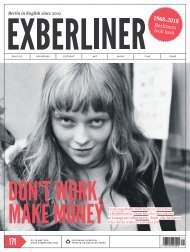EXBERLINER Issue 170, April 2018
You also want an ePaper? Increase the reach of your titles
YUMPU automatically turns print PDFs into web optimized ePapers that Google loves.
Forró for all<br />
DANCE TREND<br />
Originating in 19th-century Brazil and now popular throughout<br />
Europe, the scintillating moves of Forró have been setting<br />
Berlin’s dance floors – and a few hearts – alight. By Emily May<br />
Ellie Dempsey<br />
You’re spending your<br />
Wednesday night as you<br />
might any other, in a dimly<br />
lit, spacious bar in Prenzlauer<br />
Berg. But as the clock strikes<br />
20:00 here at Atopia Kaffeehaus,<br />
the tables are pushed aside and<br />
the innocuous setting quickly<br />
becomes a den of palpable<br />
flirtation and intimacy, incited<br />
by the Brazilian dance force<br />
that is Forró. There’s a brief<br />
class for beginners to learn the<br />
basics, before they are thrust<br />
into a sweaty hotbed of dancing<br />
couples. So close they’re almost<br />
kissing, they brush knees,<br />
cheeks and hips, as well as other<br />
dancers, forcing an overspill<br />
into the bar area, where they<br />
dodge tables of vinho drinkers.<br />
Despite your best efforts to<br />
remain a spectator, the irresistible<br />
rhythms booming from the<br />
sound system deserve more<br />
than a mere foot-tap, and you<br />
too are eventually coaxed from<br />
your seat by the fire-footed<br />
Brazilian dancer you’ve been<br />
watching all night.<br />
“Any mistake is my mistake,”<br />
he reassures you before he<br />
draws you in close, breathily<br />
singing Portuguese lyrics into<br />
your ear. But Brazilian Portuguese<br />
isn’t the only dialect you<br />
hear diffusing through the packed venue.<br />
You catch snippets of conversations in a<br />
variety of languages between dancers of all<br />
ages and walks of life, from young Englishspeaking<br />
students to mature German businessmen.<br />
Before you know it, it’s midnight.<br />
On the way home, all you can think about is<br />
the next time you’ll be led around the floor<br />
with your partner’s thigh lodged commandingly<br />
between your legs. And that’s when<br />
you realise: you’ve caught Forró fever.<br />
A<br />
folk dance originating from the north<br />
east of Brazil, Forró (literally, “for<br />
all”) has a growing community of followers<br />
in Berlin, the beating heart being the<br />
Wednesday night parties at Atopia organised<br />
by Tome Forró, a non-profit collective<br />
founded in 2013. Forró is renowned for its<br />
inclusivity; according to one theory, the term<br />
dates back to the 1900s, when workers on<br />
Brazil’s Great Western Railway would classify<br />
their weekend dance parties as either for<br />
railroad personnel only or “for everyone”.<br />
The dance culture is thriving across Europe,<br />
with prominent festivals hosted in London,<br />
Lisbon, Stuttgart and Paris to name just a<br />
few. Berlin hosted its sixth Forró festival this<br />
January, organised by Brazilian Carlos Frevo<br />
of Wedding dance school Danca Frevo.<br />
Festivals aside, the backbone of Forró in<br />
Berlin is the bustling, tightly knit community<br />
of die-hard regulars. With Brazilians,<br />
Germans, Russians, Australians and many<br />
other nationalities among their<br />
number, these Forró aficionados<br />
have become fast friends and attend<br />
every party to satisfy their<br />
dance compulsion. There are<br />
Facebook groups, but the best<br />
way to infiltrate the scene and<br />
learn about upcoming events is<br />
to get chatting with the partner<br />
you’ve been closely orbiting for<br />
the past 20 minutes. Once you<br />
do, it’s hard not to find youself<br />
inducted into this welcoming<br />
band of Brazilian enthusiasts.<br />
After attending Forró classes<br />
for just one week, you’ll probably<br />
begin to recognise familiar<br />
faces and score invites to live<br />
concerts and parties – like Ama<br />
Forró’s Sunday night dance parties<br />
on Oranienburger Straße.<br />
Taking place in the red-lit,<br />
underground environs of club<br />
Aufsturz, these Sunday sessions<br />
are organised by East Berlinborn<br />
Tobias Conradi. Having<br />
danced tango for 15 years and<br />
worked as a tango DJ, Conradi<br />
discovered Forró while studying<br />
Brazilian Portuguese and<br />
began organising parties in 2015.<br />
“I love to dance and wanted to<br />
give the opportunity to others.”<br />
Comparing his two favourite<br />
dance styles, he says, “Tango is<br />
generally more serious, whereas<br />
Forró is more relaxed.” And while the tango<br />
scene boasts a 30-year history and thousands<br />
of members, “Forró is more like a family.”<br />
One recruit to the “family” is Angela, a<br />
Hungarian former ballet dancer who<br />
stumbled upon the style by accident<br />
a year ago. “I was playing ping pong at Atopia<br />
on my birthday when the staff came over to<br />
say they had to get started with some dance<br />
thing... I’d never heard of Forró before, but I<br />
was curious so I stayed. I immediately fell for<br />
the shameless cheerfulness of the moves and<br />
the happy music.” In her view, this joyfulness<br />
is what sets Forró apart: “Salsa is much more<br />
serious, tango so dramatic. But Forró is such<br />
an unpretentious, happy dance with a lot of<br />
14<br />
<strong>EXBERLINER</strong> <strong>170</strong>

















